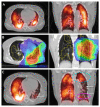Measuring Indirect Radiation-Induced Perfusion Change in Fed Vasculature Using Dynamic Contrast CT
- PMID: 36013203
- PMCID: PMC9410208
- DOI: 10.3390/jpm12081254
Measuring Indirect Radiation-Induced Perfusion Change in Fed Vasculature Using Dynamic Contrast CT
Abstract
Recent functional lung imaging studies have presented evidence of an “indirect effect” on perfusion damage, where regions that are unirradiated or lowly irradiated but that are supplied by highly irradiated regions observe perfusion damage post-radiation therapy (RT). The purpose of this work was to investigate this effect using a contrast-enhanced dynamic CT protocol to measure perfusion change in five novel swine subjects. A cohort of five Wisconsin Miniature Swine (WMS) were given a research course of 60 Gy in five fractions delivered locally to a vessel in the lung using an Accuray Radixact tomotherapy system with Synchrony motion tracking to increase delivery accuracy. Imaging was performed prior to delivering RT and 3 months post-RT to yield a 28−36 frame image series showing contrast flowing in and out of the vasculature. Using MIM software, contours were placed in six vessels on each animal to yield a contrast flow curve for each vessel. The contours were placed as follows: one at the point of max dose, one low-irradiated (5−20 Gy) branching from the max dose vessel, one low-irradiated (5−20 Gy) not branching from the max dose vessel, one unirradiated (<5 Gy) branching from the max dose vessel, one unirradiated (<5 Gy) not branching from the max dose vessel, and one in the contralateral lung. Seven measurements (baseline-to-baseline time and difference, slope up and down, max rise and value, and area under the curve) were acquired for each vessel’s contrast flow curve in each subject. Paired Student t-tests showed statistically significant (p < 0.05) reductions in the area under the curve in the max dose, and both fed contours indicating an overall reduction in contrast in these regions. Additionally, there were statistically significant reductions observed when comparing pre- and post-RT in slope up and down in the max dose, low-dose fed, and no-dose fed contours but not the low-dose not-fed, no-dose not-fed, or contralateral contours. These findings suggest an indirect damage effect where irradiation of the vasculature causes a reduction in perfusion in irradiated regions as well as regions fed by the irradiated vasculature.
Keywords: functional avoidance; lung SBRT; perfusion; post-RT toxicity; swine model.
Conflict of interest statement
J.M.R. is a shareholder in VIDA Diagnostics, Inc.; G.E.C. receives licensing fees from VIDA Diagnostics, Inc.; and J.E.B. has ownership interest in MR Guidance, LLC.
Figures









Similar articles
-
Radiation-induced Hounsfield unit change correlates with dynamic CT perfusion better than 4DCT-based ventilation measures in a novel-swine model.Sci Rep. 2021 Jun 23;11(1):13156. doi: 10.1038/s41598-021-92609-x. Sci Rep. 2021. PMID: 34162987 Free PMC article.
-
Radiation-induced airway changes and downstream ventilation decline in a swine model.Biomed Phys Eng Express. 2021 Oct 29;7(6):10.1088/2057-1976/ac3197. doi: 10.1088/2057-1976/ac3197. Biomed Phys Eng Express. 2021. PMID: 34670195 Free PMC article.
-
CT-derived vessel segmentation for analysis of post-radiation therapy changes in vasculature and perfusion.Front Physiol. 2022 Oct 17;13:1008526. doi: 10.3389/fphys.2022.1008526. eCollection 2022. Front Physiol. 2022. PMID: 36324304 Free PMC article.
-
The role of radiation therapy in treatment of adults with newly diagnosed glioblastoma multiforme: a systematic review and evidence-based clinical practice guideline update.J Neurooncol. 2020 Nov;150(2):215-267. doi: 10.1007/s11060-020-03612-7. Epub 2020 Nov 19. J Neurooncol. 2020. PMID: 33215344
-
Safety and potential increased risk of toxicity of radiotherapy combined immunotherapy strategy.Asia Pac J Clin Oncol. 2023 Feb;19(1):35-50. doi: 10.1111/ajco.13688. Epub 2022 May 10. Asia Pac J Clin Oncol. 2023. PMID: 35538049 Review.
Cited by
-
Metrics of dose to highly ventilated lung are predictive of radiation-induced pneumonitis in lung cancer patients.Radiother Oncol. 2023 May;182:109553. doi: 10.1016/j.radonc.2023.109553. Epub 2023 Feb 20. Radiother Oncol. 2023. PMID: 36813178 Free PMC article.
-
Quantifying robustness of CT-ventilation biomarkers to image noise.Front Physiol. 2023 Feb 14;14:1040028. doi: 10.3389/fphys.2023.1040028. eCollection 2023. Front Physiol. 2023. PMID: 36866176 Free PMC article.
-
Validation of CT-based ventilation and perfusion biomarkers with histopathology confirms radiation-induced pulmonary changes in a porcine model.Sci Rep. 2023 Jun 9;13(1):9377. doi: 10.1038/s41598-023-36292-0. Sci Rep. 2023. PMID: 37296169 Free PMC article.
-
The draft genome of the Wisconsin Miniature SwineTM, a valuable biomedical research tool.G3 (Bethesda). 2025 Jun 4;15(6):jkaf067. doi: 10.1093/g3journal/jkaf067. G3 (Bethesda). 2025. PMID: 40191916 Free PMC article.
-
Hypoxia Modulates Radiosensitivity and Response to Different Radiation Qualities in A549 Non-Small Cell Lung Cancer (NSCLC) Cells.Int J Mol Sci. 2024 Jan 13;25(2):1010. doi: 10.3390/ijms25021010. Int J Mol Sci. 2024. PMID: 38256084 Free PMC article.
References
-
- American Cancer Society . 2022-Cancer-Facts-and-Figures. American Cancer Society; Atlanta, GA, USA: 2022.
-
- Bradley J.D., Paulus R., Komaki R., Masters G., Blumenschein G., Schild S., Bogart J., Hu C., Forster K., Magliocco A., et al. Standard-dose versus high-dose conformal radiotherapy with concurrent and consolidation carboplatin plus paclitaxel with or without cetuximab for patients with stage IIIA or IIIB non-small-cell lung cancer (RTOG 0617): A randomised, two-by-two factorial phase 3 study. Lancet Oncol. 2015;16:187–199. doi: 10.1016/S1470-2045(14)71207-0. - DOI - PMC - PubMed
-
- Patton T.J., Bayouth J.E., Bednarz B.P., Fain S.B., Reinhardt J.M., Smilowitz J. Quantifying and Modeling Radiation Therapy-Induced Ventilation Changes and Investigating the Robustness of 4DCT-Based Functional Avoidance. The University of Wisconsin-Madison; Madison, WI, USA: 2018. Technical Report.
Grants and funding
LinkOut - more resources
Full Text Sources

